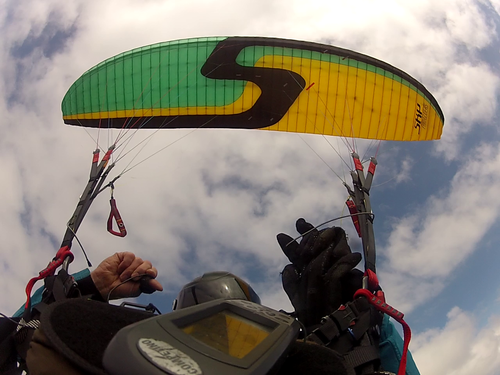Anakis 2 L |
|||||||||||||||||||||||||||||||||||||||||||||||||||||||||||||||||||||||||||||||||||||||||||||||||||||||||||||||||||


|
|||||||||||||||||||||||||||||||||||||||||||||||||||||||||||||||||||||||||||||||||||||||||||||||||||||||||||||||||||
Instability rating |
|||||||||||||||||||||||||||||||||||||||||||||||||||||||||||||||||||||||||||||||||||||||||||||||||||||||||||||||||||
|
|||||||||||||||||||||||||||||||||||||||||||||||||||||||||||||||||||||||||||||||||||||||||||||||||||||||||||||||||||
Glider characteristics |
|||||||||||||||||||||||||||||||||||||||||||||||||||||||||||||||||||||||||||||||||||||||||||||||||||||||||||||||||||
|
Launch preparations: average
launch characteristics: dynamic, climbs constantly, no guidance necessary, good feedback during inflation, moderate braking required, accelerates before zenith, control check simple, low takeoff speed
asymmetric collapse: canopy colllapses at high angle to leading edge, moderate dynamics, total course change 180-270°, (3), moderate course change rate, marked forward pitching 60-75°, (4), high height loss 40-49 m, (3), moderate sink velocity 15-19 m/s, (2), G-Force < 2,5 G, (1)
Frontal collapse: marked pitch backwards 45-60°, marked pitch forwards 45-60°, moderate dynamics, no course change, (1), immediate automatic recovery, symmetric recovery, immediate return to normal airspeed, high height loss 40-49 m, (3), low sink velocity 10-14 m/s, (1)
Spiral dives: moderate sink velocity increase, Low G-Force 3,0- 3,5 G, (1), Sink velocity after 720° <14 m/s, (1), High maximum sink velocity < 22 m/s, (3), sink velocity increase < 6 m/s on brake release, (2), Course change 180-360° after spiral exit, (2), moderate height loss during recovery 30-60 m, (2)
B-Stall: normal force required, moderate pitch backwards 15-30°, high pitch forwards 45-60°, stable sink phase, no tendency to deform, short deep stall phase < 5 s, 6-8 m/s, height loss on recovery 20-40 m
big ears: simple initiation, stable flight phase, delayed automatic recovery, Vsink unaccelerated 2,5-3 m/s, Vsink accelerated 3,5-4 m/s, Vunaccelerated 3-5 km/h less than trimspeed, Vaccelerated 5-8 km/h faster than trimspeed |
|||||||||||||||||||||||||||||||||||||||||||||||||||||||||||||||||||||||||||||||||||||||||||||||||||||||||||||||||||
Notes |
|||||||||||||||||||||||||||||||||||||||||||||||||||||||||||||||||||||||||||||||||||||||||||||||||||||||||||||||||||
|
Launch Characteristic: Skys Anakis 2 cannot be classed as an overshooter, but it did have the greatest dynamics in the te st set. With a relatively gentle impulse on the A-risers the canopy climbs quickly to the zenith where it needs a good jab on the brakes to stabilise it. Asymmetric Collapse: Anakis reacts unspectacularly to collapses performed at the minimum limit of the LFT field, however towards the maximum limit, reactions become increasingly dynamic with larger course change angles and associated height loss. Spiral Dive: Simple entry and exit B-Stall: Skys Anakis 2 enters a short deep stall on exiting from a B-stall but self recovers from this within the next 3 seconds with a marked pitch forward. Big Ears: Performing big ears on all of the tested gliders was unproblematic. |
|||||||||||||||||||||||||||||||||||||||||||||||||||||||||||||||||||||||||||||||||||||||||||||||||||||||||||||||||||
Rating |
|||||||||||||||||||||||||||||||||||||||||||||||||||||||||||||||||||||||||||||||||||||||||||||||||||||||||||||||||||
|
Safety class 4 This class of paraglider reacts demandingly to one or more of the following manoeuvres: frontal collapse, asymmetric collapse or spiral dive.Demandingly means that the above manoeuvres result in marked dynamic reactions from the glider and/or large height losses. Advanced piloting skills which need to be regularly practised, together with good personal reaction times are required to safely fly this class of gliders. Basic recovery techniques for ending a manoeuvre are not sufficient to maintain control, reduce height loss to a minimum and prevent subsequent critical reactions. Pilots should be able to recognise the onset of the above manoeuvres and be able to prevent or minimise their effects through immediate and precise pilot inputs. Additional experience such as regular ground handling and SIV training is required to safely fly gliders of this class. Special training or pilot skills which exceed standard training may be required for the safe performance of emergency descent techniques. Gliders of this Safety Class are not suitable for beginners, irregular flyers or low-airtime pilots. |
|||||||||||||||||||||||||||||||||||||||||||||||||||||||||||||||||||||||||||||||||||||||||||||||||||||||||||||||||||

